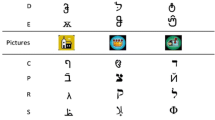Abstract
The present study examines the readiness with which equivalence classes can be formed involving gustatory stimuli, as compared with visual stimuli. In Experiment 1, two groups of normal adults were taught either visual-visual conditional discriminations or gustatory-visual conditional discriminations and were then tested to determine if classes of equivalent stimuli had formed. Equivalence classes eventually formed for all subjects. Gustatory-visual conditional discriminations required fewer training trials and equivalence classes based on these discriminations emerged in testing with fewer errors than was the case with visual stimuli. These findings were replicated within subjects in Experiment 2.
Similar content being viewed by others
References
D’AMATO, M. R., SALMON, D. P., LOUKAS, E., & TOMIE, A. (1985). Symmetry and transitivity of conditional relations in monkeys (cebus appella) and pigeons (columba livia). Journal of the Experimental Analysis of Behavior, 44, 35–47.
DEVANY, J. M., HAYES, S. C., & NELSON, R. O. (1986). Equivalence class formation in language-able and language-disabled children. Journal of the Experimental Analysis of Behavior, 46, 243–257.
HAYES, S. C., DEVANY, J. M., KOHLENBERG, B. S., BROWNSTEIN, A. J., & SHELBY, J. (in press). Stimulus equivalence and the symbolic control of behavior. Mexican Journal of Behavior Analysis.
LAZAR, R. M. (1977). Extending sequence-class membership with matching to sample. Journal of the Experimental Analysis of Behavior, 27, 381–392.
LAZAR, R.M., DAVIS-LANG, D., & SANCHEZ, L. (1984). The formation of stimulus equivalences in children. Journal of the Experimental Analysis of Behavior, 41, 251–266.
LIPKENS, R., KOP, P. F. M., & MATTHIJS, W. (1988). A test of symmetry and transitivity in the conditional discrimination performances of pigeons. Journal of the Experimental Analysis of Behavior, 49, 395–409.
MCINTIRE, K. B., CLEARY, J., & THOMPSON, T. (1987). Conditional relations by monkeys: Reflexivity, symmetry, and transitivity. Journal of the Experimental Analysis of Behavior, 47, 279–285.
PARROTT, L. J. (1984). Listening and understanding. The Behavior Analyst, 7, 29–39.
SIDMAN, M. (1971). Reading and auditory-visual equivalences. Journal of Speech and Hearing Research, 14, 5–13.
SIDMAN, M., & CRESSON, O. (1973). Reading and transfer of crossmodal stimulus equivalences in severe retardation. American Journal of Mental Deficiency, 11, 515–523.
SIDMAN, M., CRESSON, O., & WILLSON-MORRIS, M. (1974). Acquisition of matching-to-sample via mediated transfer. Journal of the Experimental Analysis of Behavior, 22, 261–273.
SIDMAN, M., RAUZIN, R., LAZAR, R. M., CUNNINGHAM, S., TAILBY, W., & CARRIGAN, P. (1982). A search for symmetry in the conditional discriminations of rhesus monkeys, baboons and children. Journal of the Experimental Analysis of behavior, 31, 23–44.
SIDMAN, M., & TAILBY, W. (1982). Conditional discrimination versus matching to sample: An expansion of the testing paradigm. Journal of the Experimental Analysis of Behavior, 37, 5–22.
SIDMAN, M., WILLSON-MORRIS, M., & KIRK, B. (1986). Matching-to-sample procedures and the development of equivalence relations: The role of naming. Analysis and Intervention in Developmental Disabilities, 6, 1–19.
SPRADLIN, J. E., COTTER, V. W., & BAXLEY, N. (1973). Establishing a conditional discrimination without direct training: A study of transfer with retarded adolescents. American Journal of Mental Deficiency, 77, 556–566.
WULFERT, E., & HAYES, S.C. (in press). The transfer of conditional control through conditional equivalence classes. Journal of the Experimental Analysis of behavior.
Author information
Authors and Affiliations
Additional information
Formerly Linda J. Parrott
Rights and permissions
About this article
Cite this article
Hayes, L.J., Tilley, K.J. & Hayes, S.C. Extending Equivalence Class Membership to Gustatory Stimuli. Psychol Rec 38, 473–482 (1988). https://doi.org/10.1007/BF03395040
Published:
Issue Date:
DOI: https://doi.org/10.1007/BF03395040




